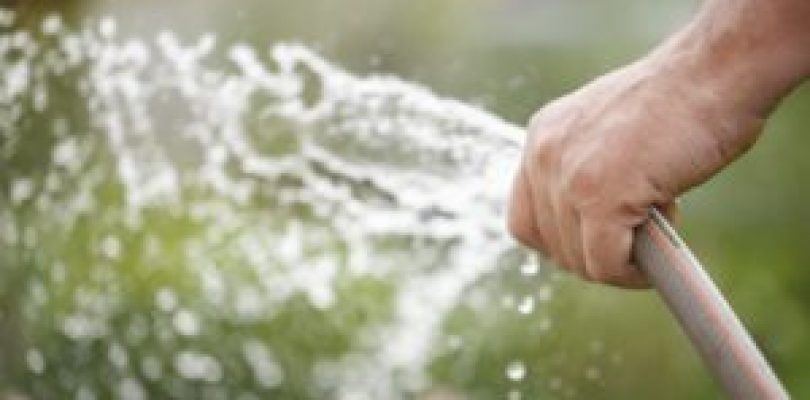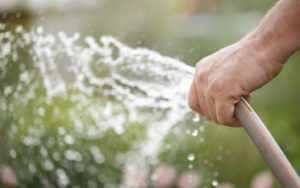 Does your marijuana plants looks unhealthy? If so, you might over watered or under watered them. When it comes to watering your marijuana plants, there are a number of factors that will determine how much and how often you should be watering them. These factors include the size of the plant, the size of the container your plant is growing in, the canopy, the root level, the temperature of the grow room, the humidity level, and which stage of growth your plant is currently in. Larger plants generally need more water than smaller plants, and larger containers won’t need to be watered as extensively. You will need to water more during hot weather, but if the humidity level is high, then you won’t need to water as much. When plants are in their final stages of the flowering phase, they consume less water and therefore you will need to water them less than normal.
Does your marijuana plants looks unhealthy? If so, you might over watered or under watered them. When it comes to watering your marijuana plants, there are a number of factors that will determine how much and how often you should be watering them. These factors include the size of the plant, the size of the container your plant is growing in, the canopy, the root level, the temperature of the grow room, the humidity level, and which stage of growth your plant is currently in. Larger plants generally need more water than smaller plants, and larger containers won’t need to be watered as extensively. You will need to water more during hot weather, but if the humidity level is high, then you won’t need to water as much. When plants are in their final stages of the flowering phase, they consume less water and therefore you will need to water them less than normal.
If you water your plants incorrectly, the roots of your marijuana plants could dry out or start to rot. In either case, the effects are detrimental to the health of your plant.
Signs of improper watering
Overwatering
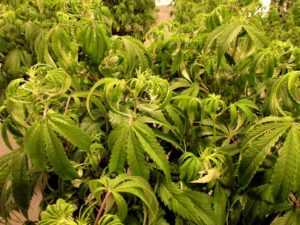 If you are watering your plants too much, their roots will start to drown. There won’t be any discoloration to indicate a problem, but the leaves will begin drooping and the overall look of your plant will be tired and unhealthy. There might also be chlorosis or yellowing of the plant’s leaves. Make sure you don’t confuse drooping plants with wilting plants, as they are caused by two opposite problems. Drooping leaves mean the entire leaf is curling, not just the tips of the leaves.
If you are watering your plants too much, their roots will start to drown. There won’t be any discoloration to indicate a problem, but the leaves will begin drooping and the overall look of your plant will be tired and unhealthy. There might also be chlorosis or yellowing of the plant’s leaves. Make sure you don’t confuse drooping plants with wilting plants, as they are caused by two opposite problems. Drooping leaves mean the entire leaf is curling, not just the tips of the leaves.
With overwatering, the growth of your plant will be extremely slow, or it might even stop. This all happens because of the anaerobic condition that develops from an overwatered plant. The roots have no use for carbon dioxide, but plenty of use for oxygen. Too much water can moisten the valuable air pockets where oxygen is stored, making less oxygen available for the roots to absorb. The roots will consequently function incorrectly and won’t be as potent as before after a while. They will also fall victim to pathogens much easier.
If your plant is experiencing these symptoms, the cause is probably due to the frequency of your watering schedule combined with a planting mix that is unable to drain the water effectively. Perhaps it is only because of drainage holes in the container since 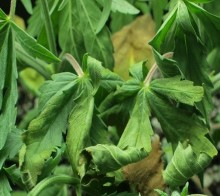 they are essential to keeping your plants’ roots from drowning. The soil itself could be made up of too small particles, meaning they are packed together more tightly and don’t let water flow through as easily.
they are essential to keeping your plants’ roots from drowning. The soil itself could be made up of too small particles, meaning they are packed together more tightly and don’t let water flow through as easily.
Underwatering
Your plants will wilt (rather than droop) and will experience slower growth if they aren’t receiving an adequate amount of water.
How to fix improper watering
A good rule of thumb to water your plants properly is to wait until the soil is drying (but not yet completely dry) and then water it enough to last it until the next scheduled watering.
Overwatering
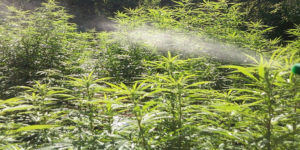 You should always wait to water until the top layer of the soil (one inch deep, or to your first knuckle) is completely dry. Then water the soil only until there’s approximately 20 percent of it draining from the bottom of your plant’s container. If you notice the soil remaining damp for a significant amount of time, either the drainage needs to change or your amount of watering needs to change.
You should always wait to water until the top layer of the soil (one inch deep, or to your first knuckle) is completely dry. Then water the soil only until there’s approximately 20 percent of it draining from the bottom of your plant’s container. If you notice the soil remaining damp for a significant amount of time, either the drainage needs to change or your amount of watering needs to change.
Sometimes growers simply lift up the pot their plant is growing in to see if it feels light or not. If it feels light to them, most of the moisture is gone and, therefore, the time for watering their plant has come. At first this might be difficult for people new to this method, so you can compare it with another pot that you fill with the same growing medium – but don’t water it. This will help you know what a “light” pot should feel like. When you do this, you can lift the actual pot with the plant in it up to see if it is similar in weight to the dummy pot. After some experience with this you should no longer require the dummy pot to know if your plant needs watering or not.
If your plant is exhibiting signs of overwatering, you should try to solve the issue immediately. First of all, if your plants are growing in containers, you should make sure that the drainage holes are clear and working well. If there aren’t any drainage holes to begin with, cut them with a knife, drill, or heat-based tool. Drainage holes are crucial for your plant’s root health.
If that is clearly not the problem, test out the soil to see if the particles are too small. Do this by watering the mix and seeing whether the water drains out freely. If it doesn’t or comes out quite slowly, the problem is probably the particle size of your soil or planting mix. It is considered to be draining too slowly if it takes more than a minute or two for you to see water coming out of the bottom. If this is indeed the problem, you can solve it by simply watering your plants less often. In the future, go with coarser soil or planting mixes that are more aerated. Keep in mind that it is especially difficult to avoid overwatering your plants if they are small but are growing in a large container.
If you are growing your plants outdoors, it could depend a lot on the natural type of soil in the area. Clay-based soils or soil that experiences heavy rainfall will not drain well. On the other hand, sandy soils might have drainage rates that are too fast. Know your soil and adjust your watering routine accordingly. The most basic way of combating an overwatering problem is to add in time between each scheduled watering, then allowing your plant some extra time to absorb smaller amounts of water until it appears happy and healthy again.
Another simple way of increasing the oxygen and decreasing the amount of moisture in any soil-based growing medium is to poke holes into the soil with a pen or pencil. This will allow the soil to aerate (have more oxygen).
For hydroponic system growers, signs of overwatering are really signs that there is a root problem. This could mean root rot is not allowing them to absorb enough oxygen, or there is not enough oxygen that has been dissolved in the water. You can use an air pump or air stones to solve this problem.
Underwatering
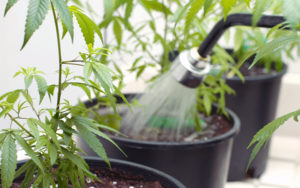 If your plants are not getting enough water, you will need to adjust your watering schedule in a different way. This problem is easier to fix that an overwatering problem – you simply need to water your plants more. If they are starting to wilt, feed them more water. When first starting to fix the problem, don’t use water that has been enriched with any fertilizer, since that will not help. Instead, use pH-balanced water that is plain to re-hydrate your plants. Once they have stopped wilting and look like their normal, upright selves, you can go back to using the fertilizer enrichment.
If your plants are not getting enough water, you will need to adjust your watering schedule in a different way. This problem is easier to fix that an overwatering problem – you simply need to water your plants more. If they are starting to wilt, feed them more water. When first starting to fix the problem, don’t use water that has been enriched with any fertilizer, since that will not help. Instead, use pH-balanced water that is plain to re-hydrate your plants. Once they have stopped wilting and look like their normal, upright selves, you can go back to using the fertilizer enrichment.
The tricky thing about underwatering is that you might not identify it at first, since slowed growth is sometimes difficult to notice. They will, however, undergo a noticeable spurt of growth if they begin receiving higher amounts of water (assuming they also have enough nutrients to begin with).
